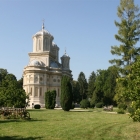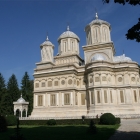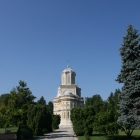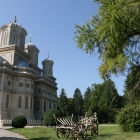The Monastery of Curtea de Arges, a spiral towards the Heaven
Five centuries of history have passed over this legendary monastery. The attribute is not arbitrary, as the Monastery of Curtea de Arges (150 km from capital Bucharest) has inspired one of the most famous popular legends in Romania. According to it, the Black King commissioned the building of a church of unseen beauty to the team of a stonemason (Mesterul Manole). Manole starts building the monastery in a haunted place, but everything they were building during the day crumbled to the ground during the night. The master craftsman has a prophetic dream from which he learned that they had to sacrifice a human being to overcome the curse. So all the workers swear that they will sacrifice the first person who comes to visit them the next day, which happened to be Ana, the young wife of Manole. Manole burried her alive in the walls of the church and so they were able to finish the project. When the monastery was over, the Black King came and was impressed of what he saw. But he asked the masons whether they could build something even greater than this. The workers, who were on the roof for final details said yes, so the King ordered for their stairs and scaffolds to be removed so no other king could hire such skilled workers. The masons built themselves wings of roof material in an attempt to escape by flying, but Manole died and in the place where he crushed a water fountain appeared.
Though this is merely folklore, we can see today a silhouette of a woman painted on the outside wall of the monastery as well as a fountain close to it. And we also know the name of the king that the ballad calls the Black King (Negru Voda). He is Neagoe Basarab who built this marvel in 5 years around 1517.
The way this beautiful monastery looks today is in great part the merit of Andre Lecomte de Nouy, the French architect who restored it in a fashion that aimed not to preserve its aspect, but rather to capture the ideal form that its builders wanted to obtain. So Lecomte de Nouy practically rebuilt the monastery in the XIX century.
Though the architecture of the church is Byzantine, what makes it unique are the spiral windows of the spires and the detailed stone lace influenced by Islamic art and by Romanian popular craftsmanship as well. The most of the original frescoes in the inside is kept in the National Museum of Art in Bucharest.
In the narthex (pronaos) of the church can be found Christian relics as well as the human remains of Romanian royalty: Neagoe Basarab, Radu de la Afumati, Carol I, the first modern king of Romania, King Ferdinand, the unifier of the country, Queen Elizabeth (his wife and poet known by her literary name Carmen Sylva) and Queen Mary of Romania.
- Home Page
start page - Architecture
landmark buildings - Sacred architecture
places of worship - Nature
landscape photography - Concert
performing artists - Christmas
Santa Claus pictures
- Jooble
jobs for photographers - Escape
an out of control blog - Merry Christmas
The best organizer of Christmas parties - Astro photo
Eclipse hunting and astrological photography





